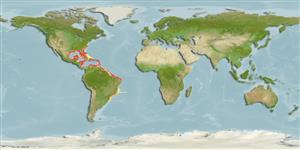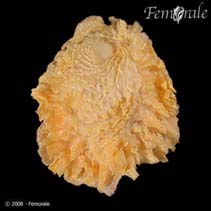Chama macerophylla Gmelin, 1791
Leafy jewelbox| Native range | All suitable habitat | Point map | Year 2050 |

|
| This map was computer-generated and has not yet been reviewed. |
| Chama macerophylla AquaMaps Data sources: GBIF OBIS |
Classification / Names Common names | Synonyms | CoL | ITIS | WoRMS
Bivalvia | Venerida | Chamidae
Environment: milieu / climate zone / depth range / distribution range Ecology
Benthic; depth range 0 - 525 m (Ref. 83435). Tropical
Distribution Countries | FAO areas | Ecosystems | Occurrences | Introductions
Western Atlantic: North America and Caribbean. Introduced in Easter Central Pacific.
Length at first maturity / Size / Weight / Age
Maturity: Lm ? range ? - ? cm Max length : 10.0 cm WD male/unsexed; (Ref. )
Short description Morphology
Brightly colored, heavy shelled bivalve with long, ribbed, leafy projections in radiating rows. Commonly yellow or orange, although some are pinkish. Inside is white. Highly variable in form, lower valve conforms to the shape of the substrate, upper valve usually becomes worn and looses color and sculpture.
Lives fixed to the substrate, with lower valve cemented in place (Ref. 3248). In Belize, it was found in a submarine cave near Columbus Cay (Ref. 87209).
Life cycle and mating behavior Maturity | Reproduction | Spawning | Eggs | Fecundity | Larvae
Members of the class Bivalvia are mostly gonochoric, some are protandric hermaphrodites. Life cycle: Embryos develop into free-swimming trocophore larvae, succeeded by the bivalve veliger, resembling a miniature clam.
Main reference
References | Coordinator | Collaborators
DeFelice, R.C., L.G. Eldredge and J.T. Carlton. 2001. (Ref. 3248)
IUCN Red List Status (Ref. 130435)
CITES status (Ref. 108899)
Not Evaluated
CMS (Ref. 116361)
Not Evaluated
Threat to humans
Human uses
| FishSource |
Tools
More information
Internet sources
BHL | BOLD Systems | CISTI | DiscoverLife | FAO(Publication : search) | Fishipedia | GenBank (genome, nucleotide) | GloBI | Gomexsi | Google Books | Google Scholar | Google | PubMed | Tree of Life | Wikipedia (Go, Search) | Zoological Record
Estimates based on models
Preferred temperature
(Ref. 115969): 14.6 - 26.3, mean 20.7 (based on 160 cells).
Price category
(Ref. 80766):
Unknown.



